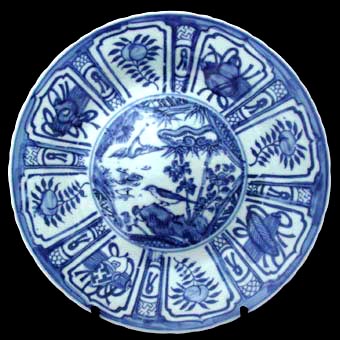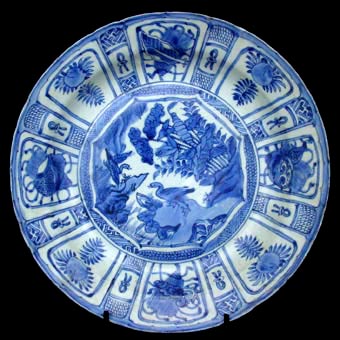

So what's wrong with which plate?
Before anything else, do not look at the density of the cobalt blue when determine which is good or bad. Any picture is deceiving and do not reflect actual true color.
The plate on the left is a not-so-good antique. It was purchased in an antique shop in Kuching, East Malaysia to be used in one of my lectures on what is good and what is not.
This new plate is made in Jingdezhen, China, the old famous kiln center that made all fine porcelain wares from the 14th century onwards. They are made from the same clay as the original pieces and looks quite similar. There are numbers of 'experts' that suggest that it is an 18th century Japanese version of the original Chinese "Kraak" plates made the early 17th century.
This type of 'fake' is available in China where many foreign antique dealers purchase them as genuine. The plates and other similar 'antiques' are later sold to private collectors.
The plate on the right is an absolute genuine Chinese "Kraak" plate which I myself recovered from our own Wanli (AD.c. 1625) shipwreck.
The difference? In detail there are many. One main point is in the color of the glaze, its transparency, the style of painting and in the shape of the foot-ring. A modern copy does not, normally, show any sand grit attached to the foot-ring as on an antique. The copies also frequently show 'dirt', painted on the foot-ring, giving the buyer a false assurance of age and wear.
This plate is also made at Jingdezhen but from a period when the potters did not had to fake any pottery. To read more about the historical production at Jingdezhen, click here.
Late Margaret Medley, one of our best-know art historian has said that you cannot see any difference between 'Mohammedan blue" or other types of cobalt oxides. The depth, density and clarity of the color varied with the maker and was often based on availability rather than the source of origin. This is also confirmed by the many shades of cobalt blue seen in all 17th century wares from the Wanli shipwreck.
Other expert suggest they can differentiate between real antique and a 'replica' by feeling the weight and "balance" of the pots. During the registration and analysis of all shipwreck ceramics we have handled, it soon becomes clear even to the less experienced handler, that each piece (from the same shipwreck and the same manufacturing date) is so different in weight and balance that no-one could tell the difference just by judging authenticity by weight or "balance". These differences were in fact just as great in early 17th century porcelain wares (despite being made in moulds) as in any other type or age of ware. Consequently, we don't believe that anyone can differentiate between good and fake pieces or newer or older pieces by feeling (or measuring) the weight or balance.
The left plate was taken to number of well-known antique dealers whom provided varying opinions. So, don't be discouraged by the difficulties in selecting genuine antique porcelains. You are in good company!
The lesson learned? Be very careful purchasing any 'antique' porcelain unless you are totally confident in the dealers ability to differentiate between the good and the bad or, better still, be sure you know where the pieces comes from.
One of these plates is about 400 years old, guaranteed. The other is brand new!
Antique dealers often inflate the price on 'fakes' to give the impression that it is a genuine artifact,
If this plate was offered to you for 300 dollars, would you buy it? Or would you rather buy this one for 30 Dollars?
 | ||||
CLICK ON IMAGES TO VIEW ARTIFACTS FOR SALE
 | ||||
CLICK ON BELOW IMAGES TO VIEW ARTIFACTS FOR SALE







